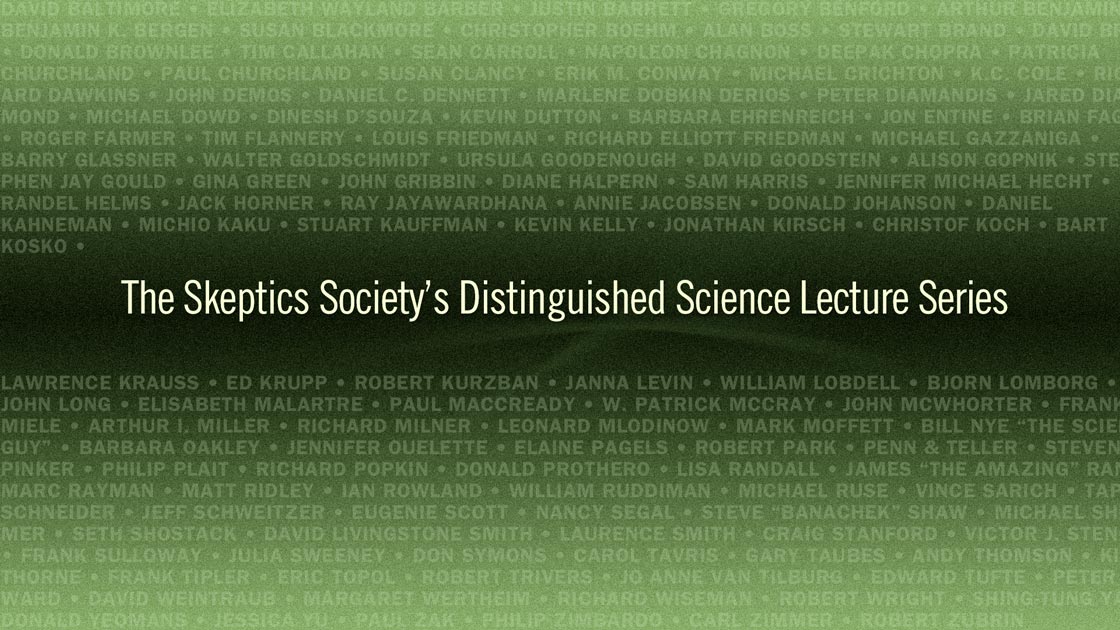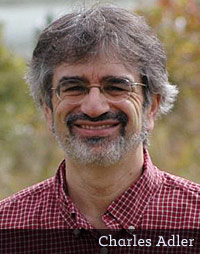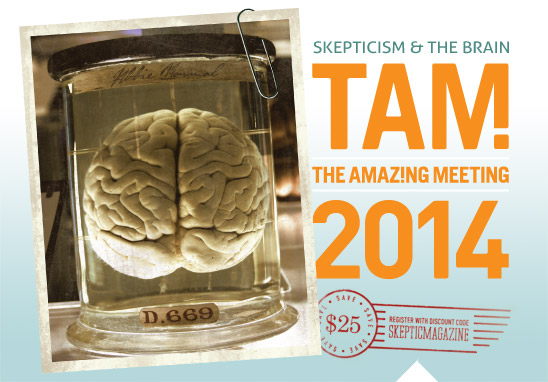In this week’s eSkeptic:
Science Lecture this Sunday
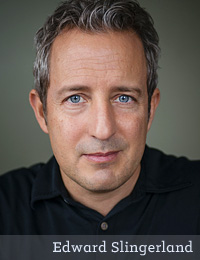
Trying Not to Try:
The Art and Science
of Spontaneity
with Dr. Edward Slingerland
Sun., Apr., 13, 2014 at 2 pm
Baxter Lecture Hall
WHY IS IT ALWAYS HARD to fall asleep the night before an important meeting? Or be charming and relaxed on a first date? What is it about a politician who seems wooden or a comedian whose jokes fall flat or an athlete who chokes? In all of these cases, striving seems to backfire. In Trying Not To Try, Edward Slingerland explains why we find spontaneity so elusive, and shows how early Chinese thought points the way to happier, more authentic lives. We’ve long been told that the way to achieve our goals is through careful reasoning and conscious effort. But recent research suggests that many aspects of a satisfying life, like happiness and spontaneity, are best pursued indirectly. Through stories of mythical creatures and drunken cart riders, jazz musicians and Japanese motorcycle gangs, Slingerland effortlessly blends Eastern thought and cutting-edge science to show us how we can live more fulfilling lives. Order Trying Not to Try from Amazon.
TICKETS are first come, first served at the door. Seating is limited. $10 for Skeptics Society members and the JPL/Caltech community, $15 for nonmembers. Your admission fee is a donation that pays for our lecture expenses.
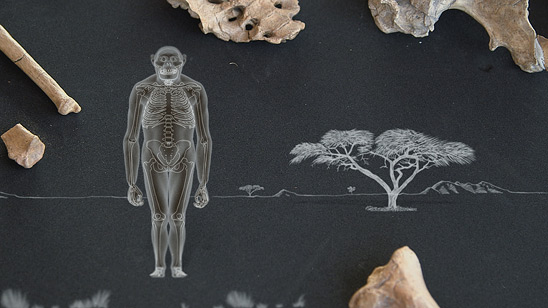
Hominids like this Australopithecus afarensis have knees angled inward, enabling a more efficient gait. Humans walk in the same way. (Courtesy of Jellyfish Pictures)
About this week’s eSkeptic
In this week’s eSkeptic, Donald R. Prothero reviews Your Inner Fish: A Journey into the 3.5-Billion Year History of the Human Body, a three-part documentary series airing on PBS beginning on April 9, 2014.
Dr. Donald R. Prothero was Professor of Geology at Occidental College in Los Angeles, and Lecturer in Geobiology at the California Institute of Technology in Pasadena. He earned M.A., M.Phil., and Ph.D. degrees in geological sciences from Columbia University in 1982, and a B.A. in geology and biology (highest honors, Phi Beta Kappa) from the University of California, Riverside. He is currently the author, co-author, editor, or co-editor of 32 books and over 250 scientific papers, including five leading geology textbooks. He is a Fellow of the Geological Society of America, the Paleontological Society, and the Linnaean Society of London, and has also received fellowships from the Guggenheim Foundation and the National Science Foundation. Read Prothero’s full bio after the article.
Share this article with friends online.
Subscribe | Donate | Watch Lectures | Shop
Discovering Your Inner Fish,
Reptile, and Monkey
by Donald Prothero
In 2008, Neil Shubin published his best-selling book, Your Inner Fish: A Journey into the 3.5-Billion Year History of the Human Body. Based on his experience teaching medical school anatomy at the University of Chicago, the book explored the evidence of our evolutionary past demonstrated in the peculiar jury-rigged anatomy of humans. Interspersed with the anatomical evidence of evolution were stories about his field work discovering important fossils that showed the transition from fish to amphibians (Tiktaalik), as well as other important finds. Shubin’s research is not only in anatomy and paleontology, but also in evolutionary developmental biology (“evo-devo”), so there were many stories in the book detailing the new discoveries in genetics that explain the oddball poorly-designed way we are constructed, and how these genetic mechanisms were inherited from our ancestors. The book was named “Best Book of the Year” by the National Academy of Sciences. After his earlier career at the University of Pennsylvania, Shubin is currently the Robert Bensley Distinguished Service Professor at the University of Chicago and Associate Dean for academic strategy of the university’s Biological Sciences Division. He was elected to the National Academy of Sciences in 2011.
Shubin’s book was such a success that it was a natural fit for a documentary series. Finally, all those years of planning and filming are about to be seen on PBS. Broken into three hour-long episodes (“Your Inner Fish,” “Your Inner Reptile”, and “Your Inner Monkey”), the TV series does visually what no book could do: take us out into the field (from the Canadian Arctic to South Africa to the hominid beds of Ethiopia to many other places) to see and understand how the fossils are found and collected, often with the famous paleontologists who made those discoveries. It takes us to the labs of geneticists and embryologists to watch experiments being done before our eyes. And it takes us into the med school anatomy lab to see parts of the human body and brain. (My young boys were a little grossed out to see the dissection of a human hand, or slicing a human brain, but it’s filmed with taste and discretion). Like any good modern film series with a budget, there are plenty of clever CG animations, from fossil creatures coming to life in Shubin’s hands, to graphics capturing the immensity of the “Tree of Life” or the landscapes of the past when these fossils were alive, to morphing the anatomy of one organism into that of its descendants.
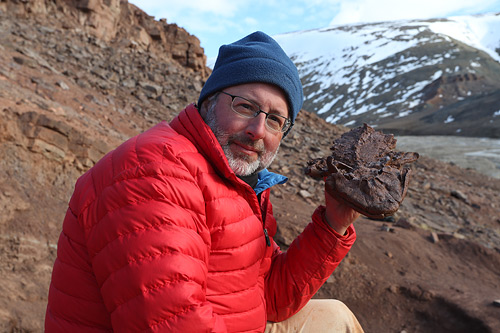
Neil Shubin with Tiktaalik Fossil. (Courtesy of Tangled Bank Studios, LLC)
Shubin reviews many of the striking examples of our anatomy that are poorly designed or jury-rigged, and can only be explained as a result of inheritance from our distant ancestors: our stumpy tail bone and poor adaptations for bipedalism; our embryonic gill slits and tail, and the pattern of bones in our limbs similar to that in lobe-finned fish; our peculiar ear apparatus that begins as reptilian jaw bones while we are embryos, then migrates to our middle ear; and many more. These are impressive, although seeing the harsh conditions of collecting fossils in the wild places like South Africa, Ethiopia, and the Canadian Arctic may impress people even more. (I was pleased when they talked about how they found the Devonian outcrops of the Canadian Arctic, and showed a map from the first edition of the classic historical geology book Evolution of the Earth by Dott and Batten. Since the 5th edition that book has been authored by myself and Bob Dott). In short, there is no shortage of stunning and impressive evidence and footage throughout all three episodes.
But in one particular way, the documentary is much more powerful than any book could be. Not only do we see the filmed footage of things that the book could only suggest in words, but we get the full impact of Neil’s charming, winning personality, his high energy and bubbling enthusiasm and excitement for what he does, and wonderful skills bringing the viewer into the wonders of evolution (something that was obvious to me when we worked together as students in the 1980s). The series introduces us to the data supporting the reality of evolution in a subtle but extremely persuasive way, without mentioning creationism or religion once, so most people who don’t already have strong creationist views will be entranced, not alienated.
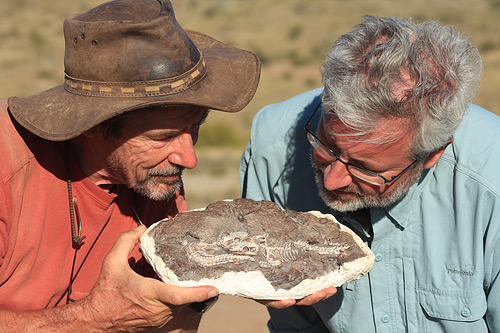
Neil Shubin and Roger Smith with two Thrinaxodon fossil.
(Courtesy of Tangled Bank Studios, LLC)
This strategy of showing the overwhelming evidence for evolution and appealing to our common sense worked remarkably well when Bill Nye beat Ken Ham in their debate in February, and for Neil DeGrasse Tyson in his current reincarnation of Cosmos (although there are digs at religion and creationism in many episodes). Shubin’s friendly, enthusiastic, non-confrontational but matter-of-fact style of showing the proof of evolution in our anatomy seems to be the best way to win over nearly everyone who is not already a hard-core creationist. Of course, the creationists are still going to be screaming bloody murder, as they are currently doing about Cosmos—but anyone with a fair mind and a willingness to listen and see the evidence will find it hard not to be persuaded by Shubin. I strongly feel that this kind of approach, broadcast to millions of viewers, will have more impact on America’s lagging public understanding of science, biology, and especially evolution, than any number of books or YouTube videos or cartoons.
After years of crummy movies and TV shows pushing pseudoscience and religious dogma and creationism, we finally have an embarrassment of riches with the airing of Cosmos and Your Inner Fish in the same month. I’m grateful for this glut of science programming, but I wish we had many such shows on a year-round basis to compete with the thousands of hours of programming of religious nonsense and pseudoscience. If we came even close to parity, maybe America wouldn’t be so embarrassingly ignorant or misinformed about science as it is now. ![]()
About the Author
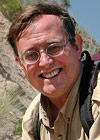
DR. DONALD R. PROTHERO was Professor of Geology at Occidental College in Los Angeles, and Lecturer in Geobiology at the California Institute of Technology in Pasadena. He earned M.A., M.Phil., and Ph.D. degrees in geological sciences from Columbia University in 1982, and a B.A. in geology and biology (highest honors, Phi Beta Kappa) from the University of California, Riverside. He is currently the author, co-author, editor, or co-editor of 32 books and over 250 scientific papers, including five leading geology textbooks and five trade books as well as edited symposium volumes and other technical works. He is on the editorial board of Skeptic magazine, and in the past has served as an associate or technical editor for Geology, Paleobiology and Journal of Paleontology. He is a Fellow of the Geological Society of America, the Paleontological Society, and the Linnaean Society of London, and has also received fellowships from the Guggenheim Foundation and the National Science Foundation. He has served as the President and Vice President of the Pacific Section of SEPM (Society of Sedimentary Geology), and five years as the Program Chair for the Society of Vertebrate Paleontology. In 1991, he received the Schuchert Award of the Paleontological Society for the outstanding paleontologist under the age of 40. He has also been featured on several television documentaries, including episodes of Paleoworld (BBC), Prehistoric Monsters Revealed (History Channel), Entelodon and Hyaenodon (National Geographic Channel) and Walking with Prehistoric Beasts (BBC). His website is: www.donaldprothero.com. Check out Donald Prothero’s page at Shop Skeptic.
Charles Adler, on Vimeo On Demand
Wizards, Aliens, and Starships: Physics and Math in Fantasy and Science Fiction
From teleportation and space elevators to alien contact and interstellar travel, science fiction and fantasy writers have come up with some brilliant and innovative ideas. Yet how plausible are these ideas? Which concepts might actually happen, and which ones wouldn’t work at all? In this lecture, professor of physics at St. Mary’s College of Maryland, Dr. Charles Adler, delves into the most extraordinary details in science fiction and fantasy—time warps, shape changing, rocket launches, and illumination by floating candle—and shows readers the physics and math behind the phenomena. Read more…
Rent this video for only $3.95
or explore the entire series.
INSTRUCTIONS: Click the button above, then click the RENT ONE button on the page that will open in your Internet browser. You will then be asked to login to your Vimeo account (or create a free account). Once you complete your purchase of the video rental, you will then be able to instantly stream the video to your computer, smartphone, or tablet, and watch it for the rental period. Videos play best on Vimeo when you allow the entire video to buffer before viewing it.
Join Us For The Amazing Meeting
South Point Casino, Las Vegas
July 10–13, 2014
How does cognitive science inform the project of skepticism? What brain sciences should you be skeptical about? Are brains hard-wired for belief in the unbelievable? Explore the science of the brain at The Amazing Meeting 2014: the world’s largest celebration of science and skepticism!
Our theme this year—Skepticism & The Brain—focusses on the cognitive and brain sciences and how they inform the project of skepticism. Keynote speakers include the acclaimed philosopher, cognitive scientist, and best selling author DANIEL DENNETT, Scientific American Editor-in-Chief MARIETTE DICHRISTINA, and MICHAEL SHERMER, Editor-in-Chief of Skeptic magazine. Other speakers include neurophilosopher Patricia Churchland, Australia’s Dr. Karl, Evolution & Human Behavior Editor-in-Chief Robert Kurzban, Brainwashed: The Seductive Appeal of Mindless Neuroscience authors Scott Lilienfeld and Sally Satel, M.D., influential memory researcher Elizabeth Loftus, clinical neurologist Steven Novella, M.D., immunologist Paul Offit, M.D., National Center for Science Education’s Eugenie Scott, psychologists and best selling authors Carol Tavris and Richard Wiseman, and many, many more!
This annual celebration of critical thinking is an unparalleled opportunity to make like-minded friends, enjoy some of the brightest minds on issues important to skeptics, and leave with tools for spreading a helpful and educational message to those who might be hurt by charlatans and unfounded belief. Join James Randi and over a thousand other like-minded folks for four days of fun, friendship, and critical thinking!
Enter “SKEPTICMAGAZINE” when registering and save $25.


